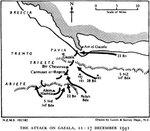syscom3
Pacific Historian
10 December 1941
SOUTH AMERICA: USN PBY Catalinas of Patrol Squadron Fifty Two (VP 52) supported by seaplane tender (destroyer) USS 'Greene' (AVD-13) and small seaplane tender USS 'Thrush' (AVP-3), begin antisubmarine patrols over the south Atlantic from Natal, and thus inaugurate operations from Brazilian waters.
NORTH AFRICA: British General Sir Claude Auchinleck, Commander-in- Chief Middle East Command, tells British Prime Minister Winston Churchill:
EDIT: Contributions by members will be marked with name of the contributor in parenthesis, like this: (Njaco).
SOUTH AMERICA: USN PBY Catalinas of Patrol Squadron Fifty Two (VP 52) supported by seaplane tender (destroyer) USS 'Greene' (AVD-13) and small seaplane tender USS 'Thrush' (AVP-3), begin antisubmarine patrols over the south Atlantic from Natal, and thus inaugurate operations from Brazilian waters.
NORTH AFRICA: British General Sir Claude Auchinleck, Commander-in- Chief Middle East Command, tells British Prime Minister Winston Churchill:
The siege of Tobruk is lifted after eight months as the Polish garrison breaks out of town early in the morning and joins other British Eighth Army forces in the Acroma area. A forward supply base is soon organized at Tobruk."Enemy is in full retreat."
EDIT: Contributions by members will be marked with name of the contributor in parenthesis, like this: (Njaco).
Last edited by a moderator:

